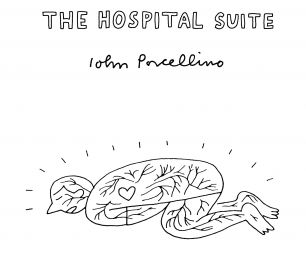Harvey Pekar’s Our Cancer Year, David Small’s Stitches, Julia Wertz’s The Infinite Wait — how do graphic novels plumb sickness so deeply?
One of the first graphic novels to brave the medical memoir was Harvey Pekar’s Our Cancer Year, which he wrote with his wife Joyce Brabner. It opens with the line:
This is a story about a year when someone was sick, about a time when it seemed that the rest of the world was sick, too. It’s a story about feeling powerless and trying to do too much. Maybe doing more than you thought you could and not knowing what to do next.
It’s a mighty first page, capturing what it is to deal with illness in a few short sentences. The line I love most from Our Cancer Year, the one that actually seems the most flippant yet really grounds the whole experience of illness is: “It’s also a story about marriage, work, friends, family and buying a house.” Life goes on even when you’re sick, whether you can keep up with it or not.
Why are stories about illness fit for graphic novels? It could be that they’re more approachable, that the cartoonish medium balances the seriousness of the subject. Memoirs like Funny Misshapen Body by Jeffrey Brown and The Infinite Wait by Julia Wertz certainly work on this level. But a memoir like David Small’s Stitches is surreal and dark; there’s nothing comic about it. No, there’s another layer to works like Marbles by Ellen Forney, which deals with mental illness. These graphic novels force us to see everything — the small moments and crippling realities — rather than gloss them over. You can see Forney’s medication laid out on the page, you can see Wertz’s terrified expression before a CAT scan. It’s one thing to imagine the surgical scar on Small’s neck, but it’s another to actually see it drawn, to see his expression as he inspects it in the mirror.
The Hospital Suite, John Porcellino’s recent graphic novel, is one of the first I’ve seen that reflects on both physical and mental illness: Crohn’s disease and, later, obsessive compulsive disorder. The book was published this September, roughly 20 years after Porcellino’s onset of Crohn’s autoimmune disorder. “The OCD was holding me back,” Porcellino tells The Comics Journal when expressing his struggle to put the book together. “When I was in the grips of the anxiety, well, it just frustrates whatever you want to do. I wanted to express it. But the OCD would find ways of throwing me off.” With time, thankfully, Porcellino was able to overcome this. The result is a book that’s strength lies in its ability to juxtapose the two illnesses: the uncertainty of an illness like Crohn’s, a struggle which Porcellino shares with his then wife, and the more private trials he has with OCD. With both, all Porcellino wants is to get better, to find some sort of solution that will allow him to enjoy life alongside everyone else again.
Though the illnesses differ, the authors all share the struggle to balance life and sickness. There are even details that overlap, like in The Hospital Suite when Porcellino’s wedding ring slips off after he’s lost so much weight and he realizes that Pekar beat him to that powerful scene in Our Cancer Year. In every memoir, it seems, the details repeat: rings fall off; blood tests, x-rays and CAT scans are done; drawing hands swell when IVs are left in for too long.
Yet every illness also carries its own uncertainty. Wertz’s The Infinite Wait is a graphic novel that came out of the author’s struggle with the autoimmune disorder systemic lupus, but it’s also the story of how she fell in love with comics: “I read them obsessively and even started making my own about mundane daily events. I didn’t really know what I was looking at or what I was doing but the proverbial light bulb went on over my head and I knew that comics were going to be my thing.”
Illness leaves many of these writers bedridden and jobless, with little else to do but spend time alone trying to recover. For Porcellino, Wertz, Forney and Brown, this time allows them to read up on their disease and figure out how to live with it. Porcellino turns to Buddhist works, while Forney turns to the DSM, Kay Redfield Jamison’s An Unquiet Mind and works by “Club Van Gogh” artists who suffered from bipolar disorder before her. In Funny Misshapen Body, Brown sometimes illustrates himself in the hospital with a comic book resting on his lap, and when Wertz isn’t illustrated discovering new comics, there remain books strewn about her room.
Illness grants each writer solitude. The awkward benefits of this time alone, as research has shown, include personal freedom, creativity, spirituality — things that ultimately feed great art. In the Philippine Journal of Psychology, researcher Eric Julian Manalastas writes, “Many thinkers, artists, and writers from Michelangelo to Kafka have taken advantage of and advocated solitude in the production of masterpieces of creative thought and expression.” Time alone creates the potential for self-acceptance and self-renewal. In the uncertainty of sickness, these artists are forced to reconsider their identity.
People tell and retell stories to put the world in order for themselves. In an interview with Rookie, Forney says, “If you’re honest, you can tell stories that other people can relate to. If it taps into certain basic human interactions and stories, that’s when it’s not just narcissism or exhibitionism — that’s when the story is worth putting out in the world.” The triumph of all of these memoirs is recovery, the ability to finally live again. And this is what they offer to others struggling with sickness or those who fear it will one day come for them — they illustrate what it is to heal and to not lose yourself to a diagnosis.
